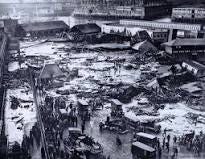The Great Molasses Flood, also known as the Boston Molasses Disaster, was a tragic event that occurred on January 15, 1919, in the North End neighborhood of Boston, Massachusetts. The disaster was caused by a massive storage tank containing over two million gallons of molasses that burst, unleashing a wave of sticky, viscous liquid that swept through the streets, causing widespread destruction and claiming the lives of 21 people.
The molasses tank was owned by the Purity Distilling Company and was used to store molasses, a thick, dark syrup derived from sugar production. The tank was located in a heavily populated area near the waterfront, and its failure sent a wave of molasses rushing through the streets at an estimated speed of 35 miles per hour.
The force of the molasses flood was devastating, with buildings being swept off their foundations, vehicles overturned, and people trapped in the sticky mass. The sheer volume and weight of the molasses made it difficult for rescuers to reach those trapped in the flood, and many victims drowned or suffocated in the syrup before help could arrive.
The aftermath of the Great Molasses Flood was chaotic and tragic. The cleanup efforts were hampered by the sticky nature of the molasses, which coated everything it touched and made it difficult to remove. The rescue and recovery operations were further complicated by the freezing temperatures, as the molasses solidified in the cold, making it even harder to remove from buildings and streets.
The disaster also raised questions about the safety of the tank and the actions of the Purity Distilling Company. It was later revealed that the tank had been poorly constructed and maintained, with inadequate safety measures in place to prevent a catastrophic failure. The company was found negligent in its handling of the tank, and a lengthy legal battle ensued to determine responsibility for the disaster.
The Great Molasses Flood had a lasting impact on the city of Boston and the surrounding area. The cleanup and recovery efforts took months to complete, and the scars of the disaster remained visible in the neighborhood for years to come. The tragedy also led to changes in safety regulations and building codes, as authorities sought to prevent similar incidents from occurring in the future.
In conclusion, the Great Molasses Flood was a tragic event that claimed the lives of 21 people and caused widespread destruction in the North End neighborhood of Boston. The disaster was a stark reminder of the dangers of industrial negligence and the importance of proper safety measures in the handling of hazardous materials.
Discussion about this post
No posts



